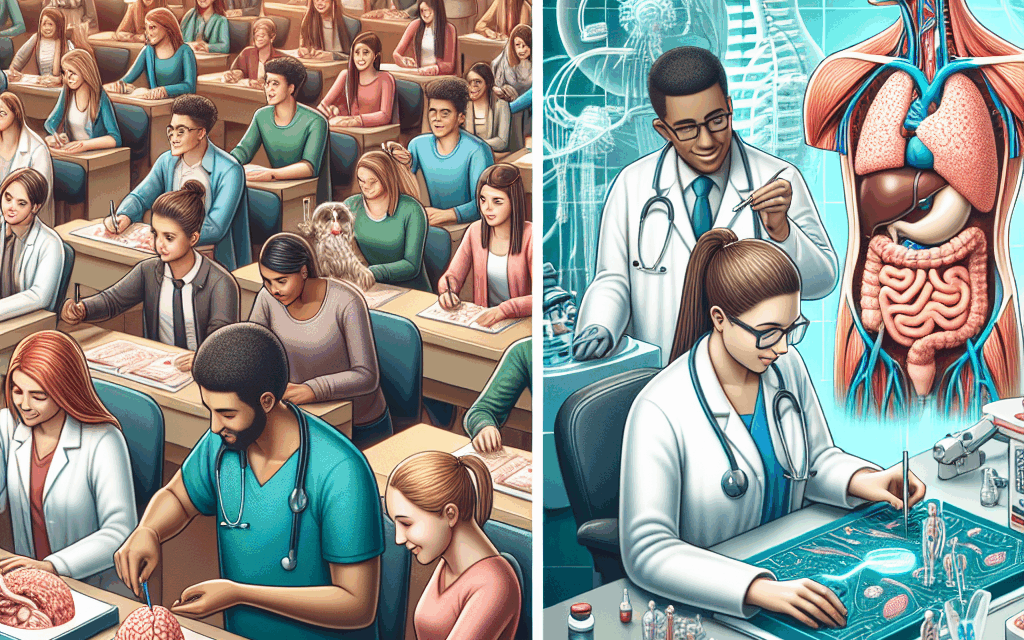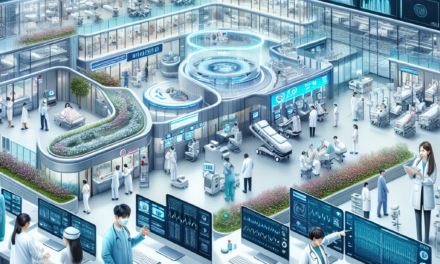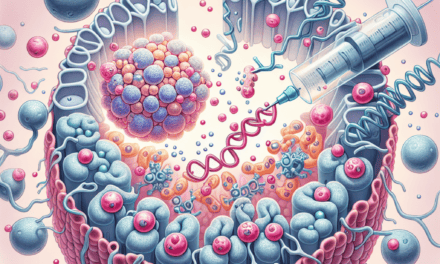The Role of Human Anatomy Education in Advancing Healthcare Innovation
Human anatomy education is a cornerstone of medical training, providing the foundational knowledge necessary for healthcare professionals to understand the complexities of the human body. As healthcare continues to evolve with technological advancements and innovative practices, the role of anatomy education becomes increasingly significant. This article explores the multifaceted impact of human anatomy education on healthcare innovation, focusing on five key areas: the integration of technology in anatomy education, the influence of anatomy knowledge on clinical practice, the role of anatomy in research and development, the importance of interdisciplinary collaboration, and the future of anatomy education in a rapidly changing healthcare landscape.
1. The Integration of Technology in Anatomy Education
The integration of technology into anatomy education has transformed how students learn and interact with the human body. Traditional methods, such as cadaver dissection, have been supplemented or even replaced by advanced technologies that enhance understanding and retention of anatomical knowledge.
1.1 Virtual Reality and Augmented Reality
Virtual reality (VR) and augmented reality (AR) have emerged as powerful tools in anatomy education. These technologies allow students to explore 3D models of the human body in an immersive environment. For instance, platforms like Oculus Rift and Microsoft HoloLens enable learners to visualize anatomical structures from various angles, providing a depth of understanding that static images cannot offer.
- Enhanced Engagement: VR and AR create interactive learning experiences that engage students more effectively than traditional methods.
- Accessibility: These technologies can be accessed remotely, allowing students in underserved areas to benefit from high-quality anatomy education.
- Safe Learning Environment: Students can practice procedures and explore anatomy without the ethical concerns associated with cadaver use.
Research has shown that students who engage with VR and AR technologies demonstrate improved retention of anatomical knowledge compared to those who rely solely on textbooks and lectures. A study published in the Journal of Medical Education found that students using VR tools scored significantly higher on anatomy assessments than their peers who did not use such technologies.
1.2 3D Printing in Anatomy Education
3D printing technology has also revolutionized anatomy education by allowing educators to create customized anatomical models. These models can be tailored to represent specific pathologies or variations in anatomy, providing students with a more relevant learning experience.
- Personalized Learning: 3D printed models can be designed to match the anatomical features of individual patients, enhancing the learning experience for medical students.
- Cost-Effectiveness: While initial investment in 3D printing technology can be high, the long-term benefits include reduced costs associated with cadaver procurement and maintenance.
- Hands-On Experience: Students can manipulate 3D printed models, fostering a deeper understanding of spatial relationships between anatomical structures.
Case studies from medical schools that have implemented 3D printing in their curricula report increased student satisfaction and improved learning outcomes. For example, the University of Michigan has successfully integrated 3D printing into its anatomy courses, resulting in enhanced student engagement and comprehension.
2. The Influence of Anatomy Knowledge on Clinical Practice
A solid understanding of human anatomy is essential for effective clinical practice. Healthcare professionals rely on their anatomical knowledge to make informed decisions regarding diagnosis, treatment, and surgical interventions.
2.1 Diagnostic Accuracy
Healthcare providers with a strong foundation in anatomy are better equipped to interpret diagnostic imaging and identify abnormalities. For instance, radiologists must have an in-depth understanding of anatomical structures to accurately diagnose conditions such as tumors, fractures, and congenital anomalies.
- Improved Imaging Interpretation: Knowledge of anatomy enhances the ability to correlate imaging findings with clinical presentations.
- Reduced Diagnostic Errors: A thorough understanding of anatomical variations can help prevent misdiagnoses.
- Enhanced Communication: Clinicians with strong anatomical knowledge can communicate more effectively with radiologists and other specialists.
A study published in the American Journal of Roentgenology found that radiologists with advanced training in anatomy demonstrated a 30% reduction in diagnostic errors compared to those with standard training. This underscores the critical role that anatomy education plays in improving patient outcomes.
2.2 Surgical Proficiency
In surgical practice, a comprehensive understanding of anatomy is paramount. Surgeons must navigate complex anatomical structures to perform procedures safely and effectively. For example, during laparoscopic surgeries, surgeons rely on their anatomical knowledge to avoid damaging vital organs and blood vessels.
- Preoperative Planning: Surgeons use their understanding of anatomy to plan procedures, anticipate challenges, and minimize risks.
- Intraoperative Decision-Making: Anatomical knowledge allows surgeons to make quick decisions during surgery, improving patient safety.
- Postoperative Care: Understanding anatomy aids in predicting potential complications and managing postoperative care effectively.
Case studies have shown that surgical teams with members who have received extensive anatomy training report higher success rates and lower complication rates. For instance, a study conducted at Johns Hopkins University found that surgical residents who participated in advanced anatomy workshops performed better in simulated surgical scenarios than their peers who did not.
3. The Role of Anatomy in Research and Development
Anatomy education is not only vital for clinical practice but also plays a crucial role in research and development within the healthcare sector. Understanding human anatomy is essential for developing new medical technologies, treatments, and therapies.
3.1 Advancements in Medical Devices
Innovations in medical devices often stem from a deep understanding of human anatomy. Engineers and designers collaborate with anatomists and healthcare professionals to create devices that are both effective and safe for patients. For example, the development of stents, pacemakers, and prosthetics requires a thorough understanding of the anatomical structures they interact with.
- Patient-Centric Design: Knowledge of anatomy allows for the design of devices that fit seamlessly within the human body.
- Enhanced Functionality: Understanding anatomical variations helps in creating devices that cater to diverse patient populations.
- Regulatory Compliance: A solid grasp of anatomy is essential for meeting regulatory standards in medical device development.
Case studies from companies like Medtronic and Boston Scientific illustrate how collaboration between anatomists and engineers has led to the successful development of innovative medical devices. For instance, the design of a new type of heart valve involved extensive anatomical research to ensure compatibility with various patient anatomies.
3.2 Drug Development and Pharmacology
In drug development, understanding human anatomy is crucial for identifying target sites for therapeutic interventions. Anatomical knowledge informs researchers about the distribution of drugs within the body and potential interactions with various systems.
- Target Identification: Knowledge of anatomy helps researchers identify specific tissues or organs that may benefit from targeted therapies.
- Pharmacokinetics: Understanding anatomical pathways aids in predicting how drugs will be absorbed, distributed, metabolized, and excreted.
- Clinical Trials: Anatomical knowledge is essential for designing clinical trials that accurately assess the efficacy and safety of new drugs.
Research published in the Journal of Pharmacology highlights the importance of anatomical considerations in drug development. Studies show that drugs designed with a thorough understanding of anatomy have higher success rates in clinical trials, leading to more effective treatments for patients.
4. The Importance of Interdisciplinary Collaboration
The advancement of healthcare innovation relies heavily on interdisciplinary collaboration, where professionals from various fields come together to share knowledge and expertise. Anatomy education serves as a common foundation that facilitates this collaboration.
4.1 Bridging the Gap Between Disciplines
Anatomy education provides a shared language for professionals in medicine, engineering, nursing, and other fields. This common understanding fosters collaboration and innovation, as team members can communicate effectively about anatomical concepts and their implications for patient care.
- Collaborative Research: Interdisciplinary teams can tackle complex healthcare challenges by combining their expertise in anatomy, engineering, and clinical practice.
- Innovative Solutions: Diverse perspectives lead to creative solutions that may not emerge within a single discipline.
- Comprehensive Patient Care: Collaborative approaches enhance patient care by integrating knowledge from various fields.
For example, the development of telemedicine technologies has benefited from collaboration between anatomists, software engineers, and healthcare providers. By understanding anatomical considerations, engineers can design telemedicine platforms that facilitate remote consultations and examinations.
4.2 Education and Training Programs
Interdisciplinary education and training programs that incorporate anatomy education can enhance collaboration among healthcare professionals. Programs that bring together students from different disciplines encourage teamwork and foster a culture of innovation.
- Team-Based Learning: Interdisciplinary programs promote team-based learning, where students learn to work together to solve clinical problems.
- Shared Experiences: Collaborative training experiences help students appreciate the contributions of different disciplines to patient care.
- Networking Opportunities: Interdisciplinary programs create networking opportunities that can lead to future collaborations in research and practice.
Institutions like Duke University have implemented interdisciplinary anatomy courses that bring together medical students, nursing students, and engineering students. These programs have resulted in innovative projects that address real-world healthcare challenges, demonstrating the power of collaboration in advancing healthcare innovation.
5. The Future of Anatomy Education in Healthcare Innovation
The future of anatomy education is poised for significant transformation as healthcare continues to evolve. Emerging technologies, changing educational paradigms, and the increasing complexity of healthcare delivery will shape how anatomy is taught and learned.
5.1 Evolving Educational Models
As technology advances, traditional educational models are being re-evaluated. Flipped classrooms, online learning, and blended learning approaches are gaining popularity in anatomy education. These models allow for greater flexibility and accessibility, enabling students to learn at their own pace.
- Self-Directed Learning: Online resources and interactive platforms empower students to take charge of their learning.
- Global Collaboration: Online learning facilitates collaboration among students and educators from around the world, enriching the educational experience.
- Continuous Learning: Anatomy education will increasingly focus on lifelong learning, encouraging healthcare professionals to stay updated on advancements in the field.
Institutions that embrace these evolving educational models will be better equipped to prepare future healthcare professionals for the challenges they will face in a rapidly changing landscape.
5.2 Lifelong Learning and Continuing Education
The importance of lifelong learning in anatomy education cannot be overstated. As medical knowledge expands and new technologies emerge, healthcare professionals must engage in continuous education to stay current.
- Professional Development: Continuing education programs focused on anatomy can enhance the skills and knowledge of healthcare professionals.
- Adaptation to Change: Lifelong learning fosters adaptability, enabling professionals to embrace new technologies and practices.
- Improved Patient Care: Ongoing education in anatomy contributes to improved patient outcomes by ensuring that healthcare providers are well-informed.
Organizations like the American Association of Anatomists offer continuing education opportunities that focus on advancements in anatomy and its applications in clinical practice. These programs are essential for fostering a culture of lifelong learning within the healthcare community.
Conclusion
Human anatomy education plays a pivotal role in advancing healthcare innovation. By integrating technology into anatomy education, enhancing clinical practice, supporting research and development, fostering interdisciplinary collaboration, and embracing evolving educational models, anatomy education is at the forefront of transforming healthcare. As we look to the future, it is essential to prioritize anatomy education as a fundamental component of medical training and professional development. By doing so, we can ensure that healthcare professionals are equipped with the knowledge and skills necessary to navigate the complexities of the human body and drive innovation in patient care.
The insights presented in this article underscore the importance of a robust anatomy education in shaping the future of healthcare. As we continue to explore new frontiers in medicine, the foundational knowledge gained through anatomy education will remain a critical driver of innovation and excellence in patient care.





